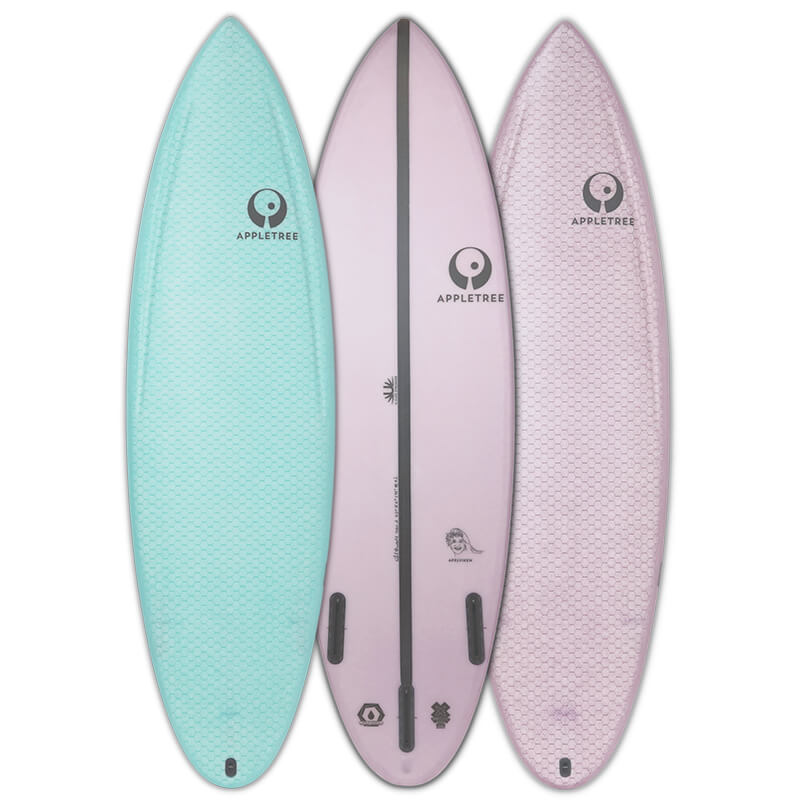When you purchase gear through links on our site, we may earn a small commission. Here’s why you can trust our tests and our affiliate partner.

Kite surfboards specific to lighter weight riders are an oft neglected market sector, with downscaled versions of the industry standard for the age-old “85kg rider” benchmark being the norm for most brands. Appletree are in a unique position, Johanna-Catharina Edin being one of their key female team riders. She’s struggled historically to find a board she’s comfortable with, and with Appletree’s unique production facility easing the prototyping process, an elegant solution was found in the new Apelviken model, named after her home spot in Sweden.
The off-the-shelf construction is with the Hex-Skin glass over a waterproof closed-cell foam, which traverses the entire Appletree surfboard range. The visible and aesthetically pleasing honeycomb layer keeps the deck tough, avoiding heel dents. Two standard pigment tints are available with a translucent pink and turquoise on offer. The joy of choosing a brand that builds to order in Europe is that if you fancy something a little special, full carbon can be specified as a custom option, as well as completely individual graphics including tail dips and any other resin art you could conceive.
It’s available in three sizes as standard (customs are also available) with a 5’0, 5’2 and 5’4 to choose from; we tested the larger 5’4 at 62kg. Shape-wise we’re presented with a rounded pin tail, which is always a lively choice and is seeing quite a comeback across the wider market in performance shapes.
With this design intention, dimensions are obviously a critical factor, and they’ve taken logical steps to tailor a board to task. The litreage on our 5’4 was sat at 20.5l. The outline and the volume distribution sits a little more centralized and suits a narrower stance with the widest point of this board at a sensible 18”, so the board still has a respectable low end considering the volume when you bring the lighter rider weight into context. The planing surface is still a decent size and feels efficient, accelerating up to planing speed easily and with a fast general cruising speed. A gentle single concave runs the whole length of the board, which flattens out towards the finboxes, nodding towards efficiency, as well as controlling chop admirably. The rocker line sits quite flat in the mid-section aiding upwind progress. These design choices and dimensions translate into a well-proportioned performance shortboard with clever volume distribution and a sensible amount of rocker, particularly in the tail, which feels precise and easy to initiate carves and throw around and release into a slide if necessary. It at no point feels corky, it’s far more fast and precise.
Other fixtures and fittings include a comfortable rail grip in the front half of the board which fades out into the tail if you want to grab the nose for some strapless freestyle action. Our board came with Futures fin boxes, but FCS2 can also be specified if preferred. The deck pad supplied is a nine piece self-adhesive affair, allowing you to opt in or out of the mid-section depending on your preference. It strikes the correct balance between having enough grip and feedback from the board without feeling too aggressive or clunky underfoot.
What’s impressive is how the shape worked in a variety of conditions; we had it out in anything from clean side offshore where its grip and control helped control an unruly kite and stay where we wanted on the wave. In onshore mushburgers, the speed and agility was impressive, again letting you get in position well and not feel overpowered, letting you decide which part of the wave you want to attack rather than having it dictated to you. Particularly when paired with faster kites under 9m, you could really feel the magic happen, which makes sense as this is what most lightweight riders will be using.
This thinner board with a more aggressive rail design allows a lighter weight rider to really bury the tail and put in a far more critical turn without feeling like they are having to force the board. It’s a far more elegant way of riding where you’re not having to fight volume and a chunky rail and compromise your riding by having to defensively manage speed. The stance feels far more natural than some boards, so you’re not forced into any weird body positions to manage power or volume, helping keep a relaxed and balanced style. For the progressive lightweight rider, it’s a truly excellent choice and just with the standard size ranges on offer, the smaller boards will cater for a 40kg humanoid, which would be ideal for a talented kid.
The Apelviken is a specific and extremely successful design exercise, which has produced a unique product in the marketplace which any smaller human should definitely consider, regardless of age or gender.
